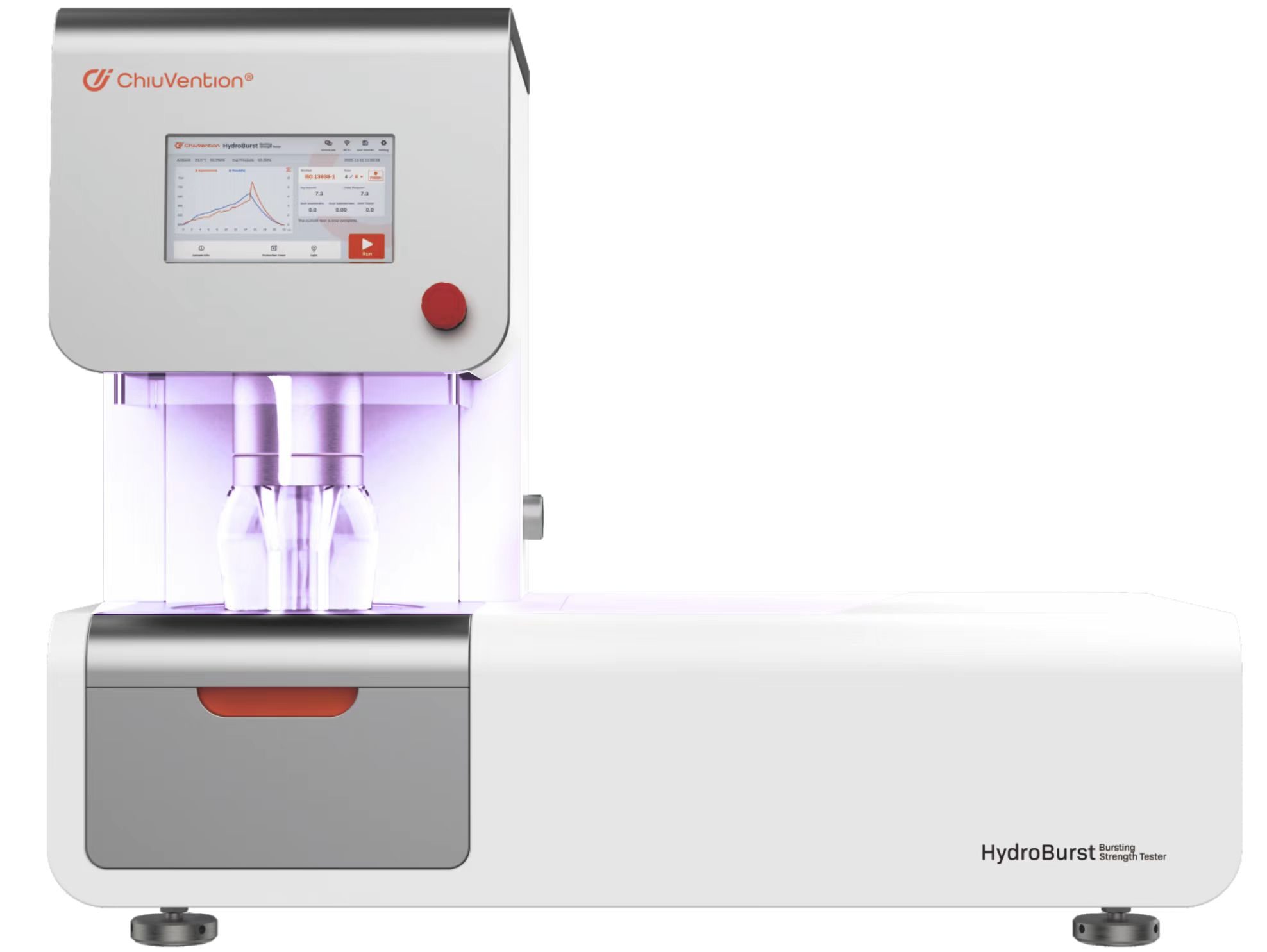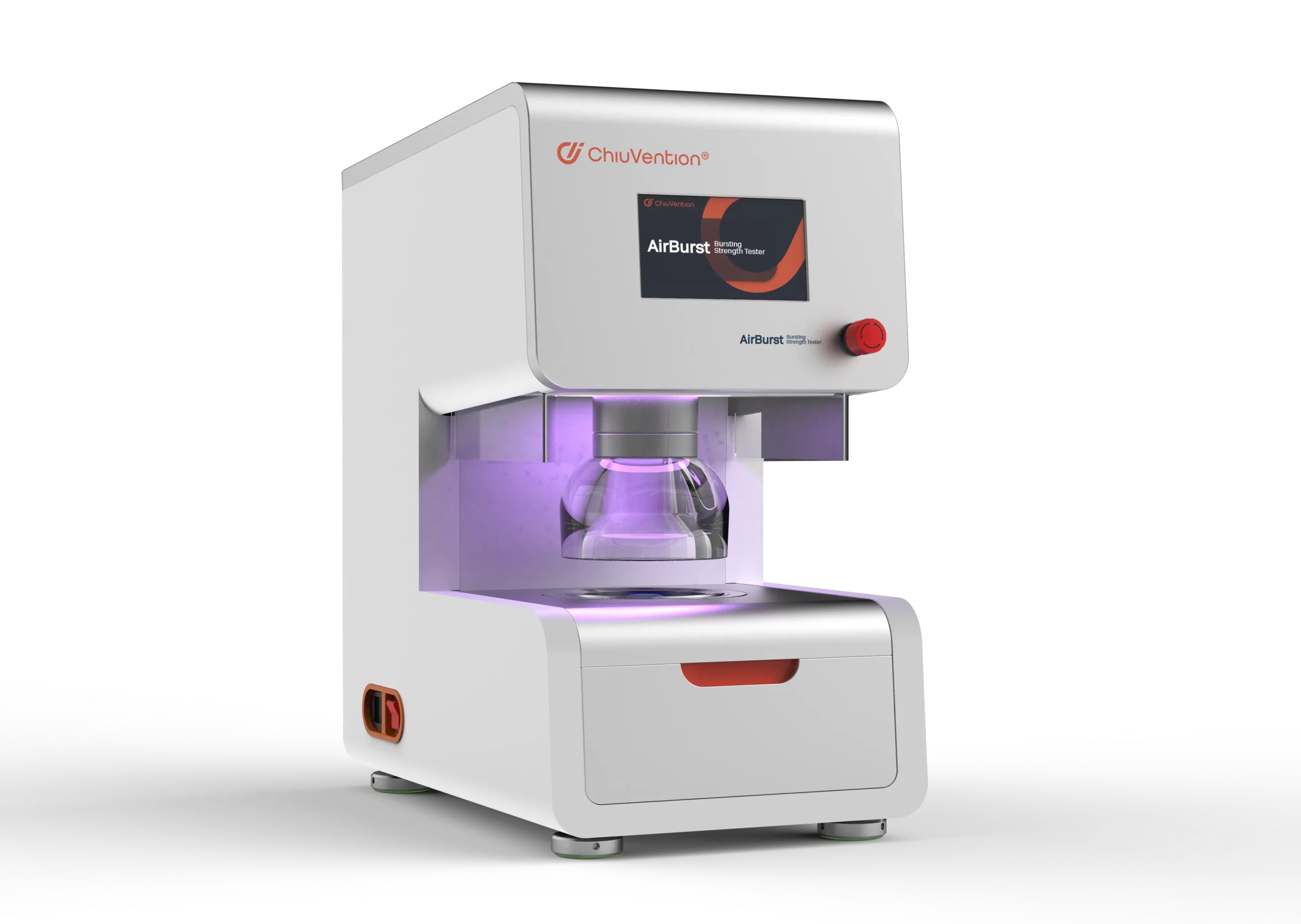Introduction
In the world of textile and material testing, bursting tests play a crucial role in determining the durability and performance characteristics of various fabrics and materials. This article delves deep into the bursting test standards, specifically focusing on GB/T7742.1, ISO13938-1, and ASTM D3786/D3786M:2013. We will explore the fundamental aspects such as test principles, instrument requirements, sample preparation, test procedures, and result calculations. By the end of this read, you will have a comprehensive understanding of these standards and their significance in the textile industry.
The previous article shared the differences between tensile and bursting tests, the standards for bursting tests, the two main methods of bursting tests, and some influencing factors. Click to review: Tensile Strength Test for Fabrics
What is Bursting Strength?
Burst strength refers to the ability of a material, particularly textiles and fabrics, to withstand pressure applied perpendicular to its surface until it ruptures or bursts. The bursting strength of fabric is an essential property in determining its durability and quality. It is commonly measured using a bursting strength test, which evaluates how much pressure the fabric can endure before failure. Understanding burst strength is crucial in various industries, as fabrics are often subjected to high levels of stress or pressure, such as in clothing, upholstery, and industrial applications. By testing the fabric bursting strength, manufacturers can ensure that their materials meet the necessary performance standards for their intended uses.
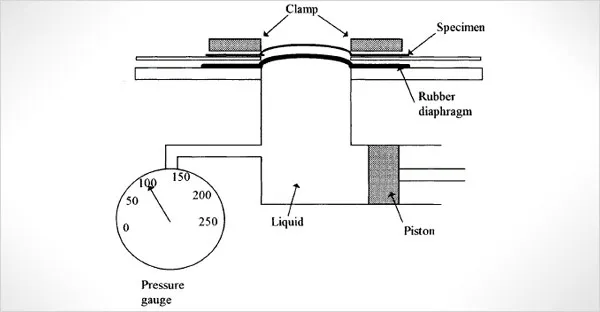
Definitions of Terms on Bursting Test
Test area: The area of the specimen within the ring clamp.
Bursting pressure: The maximum pressure applied to the specimen clamped together with the lower diaphragm until the specimen ruptures.
Bursting strength: The pressure obtained by subtracting the diaphragm pressure from the average bursting pressure.
Diaphragm pressure: The pressure required to be applied to the diaphragm to reach the average bursting expansion degree of the specimen in the absence of the specimen.
Bursting expansion degree: The degree of expansion of the specimen under the bursting pressure, expressed as the bursting height or bursting volume. Bursting height: The distance between the upper surface of the specimen before bursting and the top of the specimen under the bursting pressure.
Bursting volume: The volume of liquid required to reach the bursting pressure.
Bursting time: The time required for bursting until the specimen ruptures.
Fabric Bursting Test Standards
“Textiles – Bursting properties of fabrics – Part 1: Determination of bursting strength and bursting expansion degree – Hydraulic method”(GB/T7742.1—2005)
“Textiles – Bursting characteristics of fabrics – Part 1: Determination of bursting strength – Hydraulic method”(ISO13938-1:1999)
“Test method for determination of bursting strength of textiles using a diaphragm bursting strength tester”(ASTM D3786/D3786M:2013)
Bursting Test Principle
The specimen is clamped on an extensible diaphragm, and liquid pressure is applied under the diaphragm to expand the diaphragm and the specimen. The liquid volume is increased at a constant speed until the specimen ruptures, and the bursting strength and bursting expansion degree are measured.
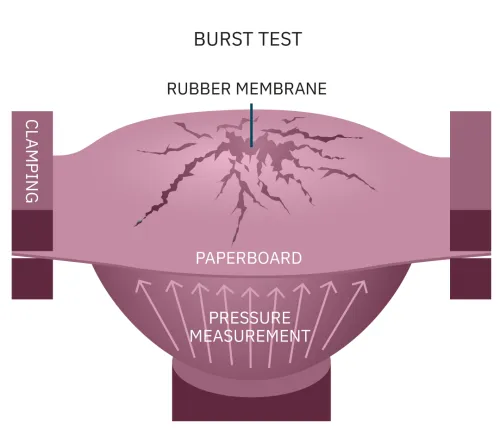
Bursting Test Instrument
For GB/T7742.1—2005 and ISO13938-1:1999, the bursting test instrument are as follows:
The metrological confirmation of the bursting tester should be carried out in accordance with GB/T19022. The
Fabric Bursting Strength Tester should meet the following requirements:
The Burst Strength Tester should have a constant volume growth rate in the range of 100 – 500 cm³/min with an accuracy of ±10%. If the instrument is not equipped with a device for adjusting the liquid volume, a bursting time of (20 ± 5) s can be used, and this should be noted in the report.
When the bursting strength is greater than 20% of the full scale, the accuracy is 2% of the full scale.
When the bursting height is less than 70 mm, the accuracy is ±1 mm. The zero point of the measuring gauge length should be adjustable at the beginning of the test to adapt to the thickness of the specimen.
If the bursting volume can be displayed, the accuracy should not exceed ±2% of the indicated value.
The test area should be 50 cm² (diameter 79.8 mm). If the preferred test area is not applicable on the existing equipment, or due to the fabric having larger or smaller elongation properties, or other requirements by mutual agreement, other test areas such as 100 cm² (diameter 112.8 mm), 10 cm² (diameter 35.7 mm), 7.3 cm² (diameter 30.5 mm) can also be used.
The clamping device should provide reliable specimen clamping to prevent specimen damage, deformation, and slippage during the test. The clamping ring should not obstruct the arch of the height-extensible fabric (whose bursting height is greater than half of the specimen diameter). The inner diameter of the specimen clamping ring should be accurate to ±0.2 mm. To avoid specimen damage, it is recommended that the inner diameter edge in contact with the specimen of the clamping ring be rounded.
During the test, the safety cover should be able to enclose the clamping device and clearly observe the elongation of the specimen during the test.
The diaphragm thickness is less than 2 mm and has high extensibility. After several uses, the diaphragm should be elastic within the bursting height range.
For ASTM D3786/D3786M:2013, the Bursting Strength Testing Machine are as follows:
A Digital Bursting Strength Tester with a pressure top is used. To prevent disputes, a Bursting Strength Apparatus tester should be used unless otherwise agreed by the buyer and seller.
The fixture can firmly and consistently ensure that the test sample is between two annular, horizontal, and parallel stainless steel plates, and there is no slippage during the test.
The upper and lower fixture surfaces each have a coaxial opening with a diameter of at least 75 mm and a hole diameter of (31 ± 0.75) mm. The fixture surfaces where the sample is placed have closed grooves with a spacing of not less than 0.8 mm, and the depth is not less than 0.015 mm starting from the edge of the hole. The fixture surface is made of metal, and the edges that cause cutting will be made into a ring with a radius of not greater than 0.4 mm. The lower fixture is combined with a chamber, and the screws in the chamber force the hydraulic medium to flow to the rubber film at a uniform speed of (95 ± 5) mL/min.
The pressure gauge is a Bourdon pressure gauge, with a gradient in pounds and an accuracy of 1% of the maximum value. The pressure gauge capacity is 25% – 75% of the total capacity.
The hydraulic system can provide controllable water pressure for the film until the water flow at a rate of (95 ± 5) mL/min bursts the sample. The displacement of the water flow is controlled by the piston in the equipment’s air pressure adjustment chamber. The valve chamber fluid is recommended to be UPS chemically pure (96%) glycerol. The water pressure system with the pressure gauge is set to prevent vibration. From the moment the sample breaks, some methods are taken to keep the volume of the air pressure chamber unchanged until all the bursting pressure and the pressure required to expand the film are recorded.
Calibration aluminum foil for preliminary testing, with a bursting strength of 70 – 790 kPa (10 – 115 psi), is used to check all the working characteristics of the tester.

Sample Preparation
For GB/T7742.1—2005 and ISO13938-1:1999: Take 5 laboratory samples, and the test area is 50 cm².
For ASTM D3786/D3786M:2013: Take 10 laboratory samples, and each sample is at least a square with a side length of 25 mm or a circle with a diameter of 125 mm.
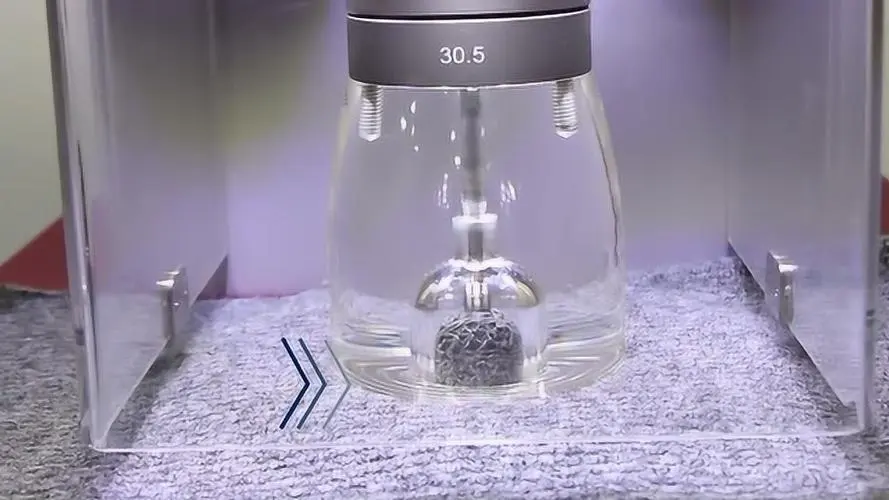
Test Procedures
For GB/T7742.1—2005 and ISO13938-1:1999, the test procedures are as follows.
The samples need to be conditioned in a standard atmosphere before the test, and ensure that the test is carried out in the specified atmosphere.
Set a constant volume growth rate between 100 – 500 cm³/min, or conduct a pre-test and adjust the bursting time of the test to (20 ± 5) s.
Place the specimen flat and without tension on the diaphragm, clamp the specimen with the clamping ring to prevent slippage during the test. Adjust the expansion degree recording device to zero, and tighten the safety cover according to the requirements of the instrument. Apply pressure to the specimen until it bursts.
After the specimen bursts, immediately reset the instrument and record the bursting strength, bursting height, or bursting volume. If the bursting position of the specimen is close to the edge of the clamping ring, report this fact. Repeat the test at different positions of the fabric to reach at least 5 test numbers. If both parties agree, the test number can also be increased.
Determination of diaphragm pressure. Using the same test area, volume growth rate, or bursting time as the above test, expand the diaphragm in the absence of the specimen until reaching the average bursting height or average bursting volume when there is a specimen, and take the bursting strength at this time as the “diaphragm pressure”.
For ASTM D3786/D3786M:2013, the test procedures are as follows.
Insert the sample under the tripod to make the sample tightly adhere to the flat plate, and make the clamping handle clamp the sample placed on the flat plate as far to the right as possible.
Turn the operating handle to the left to stretch the film.
When the film is stretching, hold the grip of the lower or right operating handle. At the moment when the sample bursts, turn the grip to move the operating rod to the neutral position and record the total bursting strength at this time.
After the break, loosen the clamping handle clamped on the sample and immediately turn the wheel counterclockwise to the initial position to release the tension on the film, and record the pressure required to expand the film.
Calculation of Bursting Test Results
For GB/T7742.1—2005 and ISO13938-1:1999, the calculation of test results is as follows.
Calculate the average value of the bursting strength in kilopascals (kPa). Subtract the diaphragm pressure from this value to obtain the bursting strength, and round the result to three significant figures.
Calculate the average value of the bursting height in millimeters (mm), and round the result to two significant figures.
If necessary, calculate the average value of the bursting volume in cubic centimeters (cm³), and round the result to three significant figures.
If necessary, calculate the coefficient of variation CV value and 95% confidence interval of the bursting strength and bursting height, round the coefficient of variation CV value to the nearest 0.1%, and the confidence interval has the same number of significant figures as the average value.
For ASTM D3786M:2013
Calculate the bursting strength of each sample by subtracting the support pressure for stretching the film from the bursting strength.
Record the bursting strength of each sample and its average value.
Main Differences Between Hydraulic Burst Tester and Pneumatic Burst Tester
The testing of fabric bursting strength is mainly divided into two methods: hydraulic method and pneumatic method, with the corresponding devices being the fabric hydraulic burst tester and fabric pneumatic burst strength tester. There are significant differences between the hydraulic burst tester and the pneumatic burst tester in terms of working principles, application scenarios, performance characteristics, and operating methods.
The hydraulic burst tester applies pressure using a liquid (such as water or oil) to burst the sample. Its pressure control is precise and stable, making it suitable for various textiles, films, and environments that require high-precision measurements. It is widely used in laboratories and quality inspection agencies. On the other hand, the pneumatic burst tester uses gas (such as air) to apply pressure. Due to the fast adjustment of air pressure, it is ideal for rapid testing of large quantities of samples, such as in production line quality control. Additionally, the pneumatic burst tester uses air as the medium, which is pollution-free and meets environmental requirements.
In terms of performance, the hydraulic burst tester provides more stable and precise pressure, making it suitable for high-precision testing needs. However, it is more complex to operate, and its maintenance cost is higher. In contrast, the pneumatic burst tester is easy to operate, maintenance is more convenient, and the equipment is generally lighter and more portable, making it suitable for quick on-site testing.
The hydraulic burst tester is ideal for tests requiring high precision and stability, while the pneumatic burst tester is better suited for rapid testing and scenarios with high environmental requirements.
Choosing the appropriate burst tester based on specific testing needs and application scenarios can help ensure the accuracy and reliability of the test results.
HydroBurst Bursting Strength Tester
The HydroBurst bursting strength tester, a type of hydraulic bursting strength tester, uses the hydraulic bursting (elastic diaphragm method) to measure the expansion force and expansion degree of knitted fabrics, woven fabrics, non-woven fabrics, laminated fabrics, elastic woven fabrics, paper, and other materials when they are simultaneously stressed in the warp, weft, and all directions, that is, the anti-bursting performance of the materials. It is applicable to standards such as FZ/T01030 – 2016 Method B, GB/T 7742.1 – 2005, ISO 13938 – 1 – 2019, ASTM D3786/D3786M – 18(2023), and EN 12332 – 2 – 2002.
AirBurst Bursting Strength Tester
AirBurst Pneumatic Burst Tester checks the strength of textiles, films, paper, and foam. It’s easy to use and maintain.
This Burst Strength Tester tester has four modes: constant speed, constant pressure, constant dilatancy, and timed expansion. These modes show how well the sample resists expansion.
Conclusion
Mastering the bursting test standards is essential for ensuring the quality and reliability of textile and material products. By adhering to these standards, the industry can produce materials with consistent and predictable bursting resistance, meeting the demands of various applications. Whether it’s for clothing, upholstery, or industrial fabrics, accurate bursting testing is the cornerstone of product durability and performance.
For manufacturers seeking to invest in bursting strength testers, understanding the bursting strength tester price is crucial to making an informed decision. The bursting strength apparatus plays a vital role in ensuring accurate testing results, and selecting the right equipment from reliable bursting strength tester manufacturers ensures long-term durability and performance of textile products. By choosing the appropriate bursting strength tester and apparatus, companies can ensure that their products meet industry standards, minimizing risks and maximizing quality assurance.
For any textile-related questions or advanced testing solutions, reach out to experts who can guide you through every step of achieving the best bursting strength test results.
Email: sales@chivention.com
WhatsApp: +86 180 2511 4082
